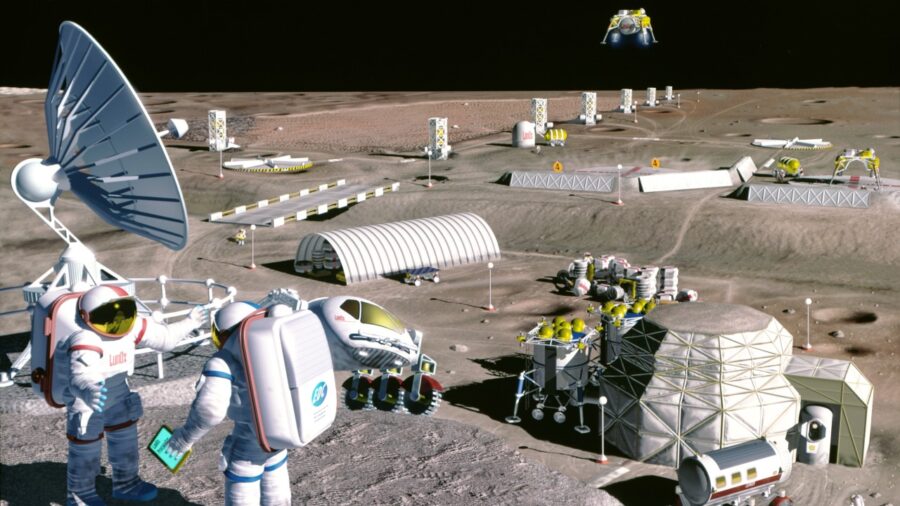China Is Actually Making An Underground Moon Base

The concept of establishing a moon base has intrigued scientists and space enthusiasts for years. Recently, Chinese researchers have reignited this fascination by delving into the prospects of setting up a long-term shelter within the lunar lava tubes. These remarkable structures were formed during the Moon’s youthful days, as the hardened upper crust of lava flows enclosed a channel of continued molten rock activity, eventually forming stable hollow tunnels beneath the surface.
Like the greatest of Saturday morning cartoon villains, Chinese scientists are looking into establishing an underground moon base using existing lava tubes.
Years of geological transformations, including impact events and moonquakes, have shaped these tubes, creating what is known as “skylights” — accessible openings to the mysterious underground realm of the Moon. According to University Today, Zhang Chongfeng, from the Shanghai Academy of Spaceflight Technology, shared these fascinating insights during the 10th CSA-IAA Conference on Advanced Space Technology in Shanghai. Being the vice chief designer of China’s Shenzhou series spacecraft and lunar landers, Zhang’s introduction to this study has spurred a wave of excitement within the scientific community concerning the potential of a moon base.
Zhang pointed out the protective nature of the lunar lava tubes, providing a sanctuary from the Moon’s severe surface conditions, including extreme temperatures, radiation, and constant micrometeorite impacts. These qualities make the tubes viable for a moon base, offering a shielded environment for long-term habitation. To enhance their comprehension of the tubes’ structure and stability, Zhang’s team, in collaboration with China’s planetary geology experts, carried out extensive fieldwork in several of Earth’s lava caves with the goal of drawing comparisons to their lunar counterparts.
An underground moon base sounds strange, but the science behind it is remarkably sound and could have an impact on building techniques here on Earth.
Through careful examination, Zhang conveyed that there is a remarkable resemblance between Earth’s and Moon’s lava tubes. These tubes can be essentially categorized into two types: the vertical entrance tube and the slope entrance tube. The prevalent form is the vertical entrance tubes; they feature a collapsed skylight with an accumulation of debris and soil, demanding specialized vertical lifting equipment or flight capabilities for entry, while the sloping entrance tubes, due to their semi-collapsed nature, offer a direct pathway into the moon base through the collapsed structure.
For initiating this ambitious venture of setting up a moon base, Chinese researchers have earmarked lunar lava tubes at Mare Tranquillitatis and Mare Fecunditatis as primary exploration targets. The careful crafting of exploration plans is already in progress, with the primary probe anticipated to deploy a robotic mobile system outfitted with feet or wheeled appendages. This sophisticated mechanism will ensure the probe’s adept adaptation to the complex lunar terrain, efficiently navigating through and around obstacles while carrying auxiliary detectors to ensure communication relay and energy support.

Moreover, these auxiliary detectors will diversify functionalities, engaging in activities like bionic multi-legged crawling, bouncing, and rolling detections. They are meticulously designed to assess a range of parameters, including temperature, radiation, lunar dust, soil composition, and the presence of water ice within the lunar tube. Concurrently, a flight detector will soar through caves with rugged terrain and significant drops, employing microwave radar and laser radar for autonomous obstacle avoidance in the dark, eerie voids of the lunar caves.
For initiating this ambitious venture of setting up a moon base, Chinese researchers have earmarked lunar lava tubes at Mare Tranquillitatis and Mare Fecunditatis as primary exploration targets.
Zhang visualizes a grand blueprint for the creation of a crewed moon base in the near future. The exhaustive plan starts with forming a lunar underground research base, starting with constructing an energy and communication support center at the entrance of the lava tube. Subsequently, terrain landscaping and cabin deployment within the lava tube will facilitate the establishment of research and residential quarters, fortifying the groundwork for a moon base.
This bold venture showcases China’s unyielding drive for space exploration, notably with the China Manned Space Agency aiming for a manned lunar landing by 2030. As we near the dawn of a moon base, the collaborative quest to learn more about the lunar lava tubes stands as a major leap for China and a promising beacon for humanity’s broader cosmic presence. This endeavor, fusing geological, engineering, and astronomical expertise, not only reshapes the boundaries of what’s attainable but also signals a new era of space exploration and colonization.












